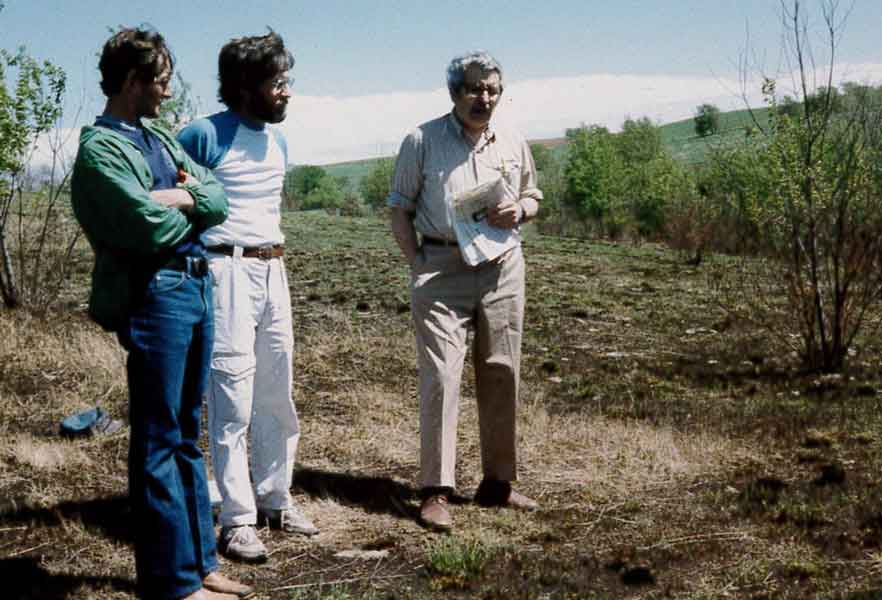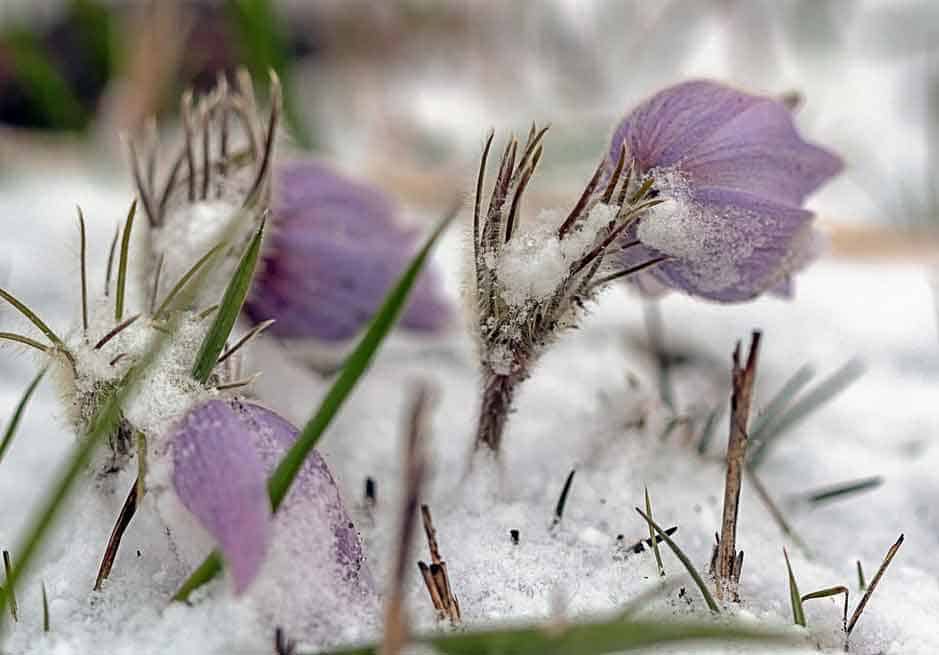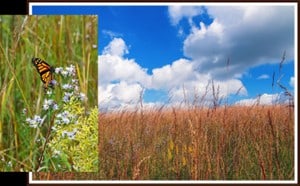
Butenhoff Prairie
Butenhoff Prairie is a 19.5-acre broad-back hill in rural Green County. The Green County Conservation League purchased the hill from Harrison and Marion Butenhoff in 1988, and TPE bought the property in 2005. The remnant prairie sod still contains the original vegetation that greeted the first settlers in Green County in the late 1820s.
Two state listed plants are present. Hill’s thistle (Cirsium hillii) and prairie Indian plantain (Arnoglossum plantagineum) are both listed as Threatened in Wisconsin by the Department of Natural Resources. A third plant, prairie turnip (Psoralea esculenta) is shown on old plant lists but has not been seen recently.
There is a long hike into the prairie, so this is considered a difficult walk.
The photo at the above was taken May 15, 1988 at the dedication of Butenhoff Prairie. From left: Kim Christen, president of the Green County Conservation League, John Ochsner and Dr. Hugh Iltis
ACCESS & DIRECTIONS
Located roughly 1/3 mile north of the intersection CTY FF and Ladwig Road, located in the southeast quarter of Section 5 of Sylvester Township (T2N, R8E) in Green County. There is no easy access to this site, no fire number, no marked entrance lane or parking lot. Instead we have a 20-foot wide driveway easement north from County FF, between Dutch Hollow and Ladwig Roads that follows fence lines approximately two-thirds of a mile to the base of the broad hill. It is not recommended that visitors attempt to take passenger cars off-road to the site. When we have work days or field trips we meet along County FF and take 4-wheel drive trucks, which can navigate the hills, wet spots and steep climb up onto the limestone ridge.
Google Map
Description & Significance

Photo credit: Jerry Newman
The property is dry to mesic prairie, dominated by the short grasses – little bluestem (Schizachyrium scoparium), side oats gramma (Bouteloua curtipendula) and prairie dropseed (Sporobolus heterolepis), with some big bluestem (Andropogon gerardii) and Indian grass (Sorghastrum nutans). It is rich is forbs, especially, asters and goldenrods. The property is an irregularly shaped polygon of eight sides with a narrow band of trees and brush around the north, west and south sides.
Butenhoff Prairie is significant in that its thin, rocky soil has prevented most of it from being plowed, although it most likely has been grazed by horses, sheep and cattle. Flint, chert and other small chunks of limestone and dolomite rocks are present near the surface of the bluff, forming a cap over sandstone slopes that in turn lie above level, fertile ground. There is a barb-wire fence along the east border of the property, and the other three sides are a brushy woodlot, especially where it is steep on the west and south edges.
Forty years ago when this land was first found to be remnant prairie, upland sandpipers were common nesting birds. The state-listed regal fritillary (Speyeria idalios) was once seen. However, since that time much of the surrounding area has been converted to housing and agricultural, reducing available grasslands from several hundred acres to a mere 20 acres. Formerly open areas have grown up the trees and brush. Eastern meadowlarks, bobolinks, grasshopper sparrows, field sparrows and dickcissels are still found nesting here most summers.
Butenhoff Prairie features several small plum groves, which we protect from fire, plus hawthorns and the native Iowa crab.
Usage Policies
Allowed:
- Outdoor Recreation
- Hunting (for all species, no permit or reservation required)
Ownership History

Photo credit: Jerry Newman
The preserve was purchased in January, 1988, by the Green County Conservation League from Harrison and Marian Butenhoff. It was subsequently sold in 2005 to The Prairie Enthusiasts. It is owned outright in fee simple by TPE, with a legal easement from County FF through two parcels of land.
It was pure serendipity that this was ever preserved. This land was owned by Harrison Butenhoff, a Monroe businessman who was a member of the Green County Conservation League. In the 1970s he contacted the Green County conservation people with the idea of planting pine trees on his property. The tree-planter was another member of the league, Gary Eldred, who was also a prairie enthusiast. Eldred informed Butenhoff that he owned an unusual piece of Green County – prairie – and this rare ground would be lost forever if it were planted to trees. So, over the next several years, arrangements were made to sell the land in 1987 to the Green County Conservation League. Within a few years, the league realized that a better fit would be for ownership and management to be transferred to the newly organized Prairie Enthusiasts.
The original protection of this property coincided with the publication of Rudy’s Hill – The High Point in the Valley and A View of Life Beyond the Horizon by Manuel Conrad Elmer, whose memoir of growing up in Dutch Hollow was written as he approached his 100th birthday in 1986. His stories of learning the birds and bees, flowers and trees from his Swiss-born grandfather while they tramped the land surrounding what we now call Butenhoff Prairie, lends charm and literary history to the property.
“Boots got the idea that M.C. Elmer’s Rudy’s Hill included his hill prairie,” remembers Gary Eldred, “and I think that clinched the deal for him to sell the land to the league. He wanted it preserved.”
Management
The first burn at this site was conducted in the spring of 1988 by the league, many of whom were also Prairie Enthusiasts – Eldred, John Ochsner and Gary Felder. This burn was held at night and attracted large numbers of spectators, whose cars lined County FF to see the rare sight of a prairie afire at night. On the day before the transfer of title was to be celebrated by TPE in 1993, the league inadvertently set fire to the prairie, so that on dedication day there were no flowers to be seen, only blackened soil. Dr. Hugh Iltis was The Guest Speaker that day in 1993, and the prairie enthusiasts had to travel to nearby Sulzer Prairie to see any spring flowers.
Early efforts by both the league and The Prairie Enthusiasts to restore the prairie to its original condition did not include herbicide use on the cut stumps, so that all of the cherry, walnut, elm and honeysuckle quickly re-sprouted. Management techniques had improved by 2009, and in recent years all the invasive trees and most of the brush have been removed – permanently this time. Plants introduced by the league include compass plant, pale purple coneflower, wild quinine and rattlesnake master.
Tom Mitchell, the site steward, has organized work parties since 2009. Work parties are held periodically during three seasons; our access is generally impassable during winter due to snow, ice or muddy conditions.
Seasonal work at Butenhoff Prairie emphasizes the control of weeds and brush during the spring and summer months. Non-native plants of lesser concern are the sweet clovers, wild parsnip and wild carrot, which are managed by hand when present in small patches and mowed when found in larger patches. Trees and brush have been removed from a former fence line on the northern boundary.
The southeastern portion of Butenhoff Prairie has an infestation of the non-native leafy spurge (Euphorbia esula), a perennial that is native to Europe and Asia. It is deep-rooted with milky sap in all parts of the plant. In Wisconsin, it is a restricted plant –an invasive this is already established in the state and has the potential to cause significant environmental or economic harm. Leafy spurge is one of five “noxious” weeds in Wisconsin, and according to the Invasive Plants Association of Wisconsin (IPAW), it can quickly create monocultures, excluding native vegetation and reducing wildlife habitat value. We have used bio-controls – flea beetles – to reduce the prevalence of leafy spurge.

